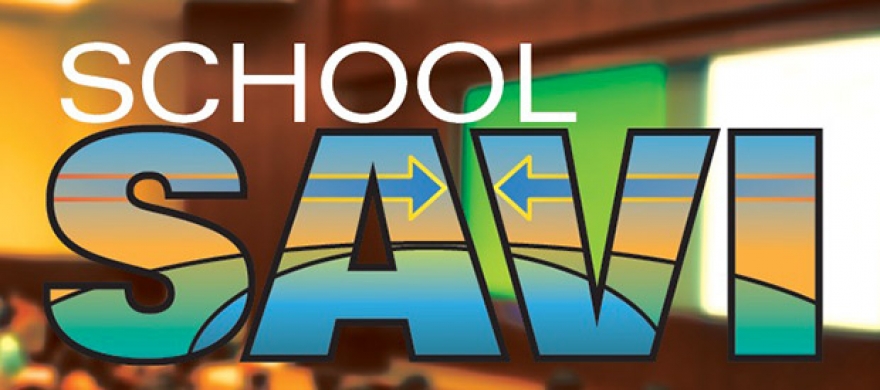School SAVI
A lifelong educator takes the lead to change the future of the classroom at home and beyond.
Back in the 1970s, then University of Chicago graduate student Eric Hamilton found himself in a situation that nearly every eighth-grade algebra teacher faces.
“I would notice that three specific students were always ahead of everyone else,”
he explains. “When the other students saw these three classmates raise their hands,
they just stopped working. If I called on the advanced students, they became reinforced.
If I didn’t, they got frustrated.” Listen to Eric Hamilton talk about two other SAVI projects he and his team are working
on to change the future of education.
Listen to Eric Hamilton talk about two other SAVI projects he and his team are working
on to change the future of education.
Hamilton thought that if he had a better sight line into what they were doing, he could give them the feedback that was necessary to keep them from being bored or becoming too frustrated. He envisioned a computer-based tool that allowed teachers to see what every student was doing at his or her desk, comment, and reinforce them personally and anonymously. “I wanted to make sure what I was giving them matched their abilities,” he recalls.
This idea brought about his invention and patenting of one such pen-based computing technology—SlateMate, a local network-based multimedia workspace that enables teachers, students, or groups thereof to interact simultaneously and anonymously—and became the defining way that he looked at how teachers could use technology.
Remaining in the field of pen-based computing decades after completing his graduate studies, Hamilton organized the first Workshop on the Impact of Pen and Touch Technology in Education (WIPTTE) at Pepperdine in 2006, a conference that shares research and effective practice on the use of these tools in K-12 and higher education.
Today, Hamilton is seeking another breakthrough. Following decades of researching learning technology innovation and learning environments of the future, the professor of education at the Graduate School of Education and Psychology has signed on to represent the United States in leading a joint research plan with Finland in hopes of marshaling new technologies in imaginative ways.
Harnessing Finland’s exemplary reputation for academic success and the United States’ commitment to education, this project aims to apply the best ideas from both countries to kindergarten through undergraduate learning environments.
Funded by the National Science Foundation (NSF) in partnership with two counterpart federal agencies in Finland, the endeavor, called SAVI (Science Across Virtual Institutes), is a collaborative vehicle that will enable broad-based teamwork on advances in learning and instruction, particularly in science, technology, engineering, and mathematics (STEM) education. This is the first collaboration of its kind.
“We’re trying to find conditions for designing learning environments in which both students and teachers are fully absorbed in the material,” explains Hamilton. “The settings we are trying to create and test are ones where students or teachers are regularly ‘in the zone,’ when total immersion the lesson invariably follows.”
SAVI emphasizes the integral roles that other disciplines, such as creativity and the role of imagination in problem solving, play in STEM education, a key portion of the public education agenda of the United States.
Hamilton and a diverse team of educators from around the world have embarked on eight complementary projects that examine common topics of engagement in learners and learner communities, such as the use of games and digital media to teach and using new technologies to simplify the reading and comprehension of science texts.
In SAVI’s final stages, after monitoring and collecting their findings and insights, the team plans to hold webinars aimed at educators, researchers, and policymakers.
“We know that students do not live in a high state of engagement in classrooms. That’s a pretty common experience for most people, that they don’t feel like they are deeply immersed for most of the day in what they’re doing,” Hamilton explains. “If they’re not engaged, if they feel that the work that they’re doing is too easy or hard, they get bored or frustrated. Finding that sweet spot where they’re productively engaged in disciplinary content ... that’s the Holy Grail to me.”
Of the eight research projects, Hamilton is focused on three. The first involves analyzing the effectiveness of massive open online courses (MOOCs) in the teaching and learning of calculus by high school students and undergraduates. MOOCs are web- based, interactive courses open to the public, aimed at creating a community among students, educators, and teaching assistants. This groundbreaking endeavor hopes to recommend best practices on the design, deployment, and analysis of this and other MOOCs.
“The fact that students can, for example, share information and data that they collect in outdoor settings and make videos of things they observe in a local context and interpret that in media that they make gives more immediacy to what they’re learning,” says Hamilton.
“That gives more opportunities to more students and, when they have access to technologies and can access large amounts of information, it helps bridge the gap between learners and teachers. Social networks and communities change what we learn and how we learn and how we interact with others.”
Under Hamilton’s guidance, Pepperdine will use the SAVI award to send 24 early-career- and teacher- researchers from some of the most exciting learning technology research programs around the country (including Pepperdine) to Finland in the coming year for one-to-six-week stays at different education labs there. Pepperdine will also host a series of educational policy, innovation, and research webinars led by different members of the SAVI consortium. Hamilton’s ultimate goal is to connect developing nations as well as U.S. organizations with SAVI.
“We are seeking ways to take research innovations and position them onto a path of
entrepreneurship and economic sustainability,” says Hamilton. “I consider myself unbelievably
fortunate to be involved in SAVI, because I think it has so much potential, and the
people both in Finland and in the U.S. have done so many amazing things in education
that can be woven together. This work is critical to our humanity and to our progress
in building a fair, free, and prosperous society.”
Why STEM Matters
“STEM” was formally adopted by the National Science Foundation in 2001 to refer to
four overlapping academic disciplines—science, technology, engineering, and mathematics—that
are becoming more important to our culture and society as the workforce demands more
experts in those fields. As industries such as information technology and the geosciences
grow and change due to the rise of technology and innovation, workers are required
to become proficient in new sets of skills. By focusing on students’ engagement and
skills at an elementary level, STEM-based education supports raising the proficiency
level of both teachers and students of all abilities.
